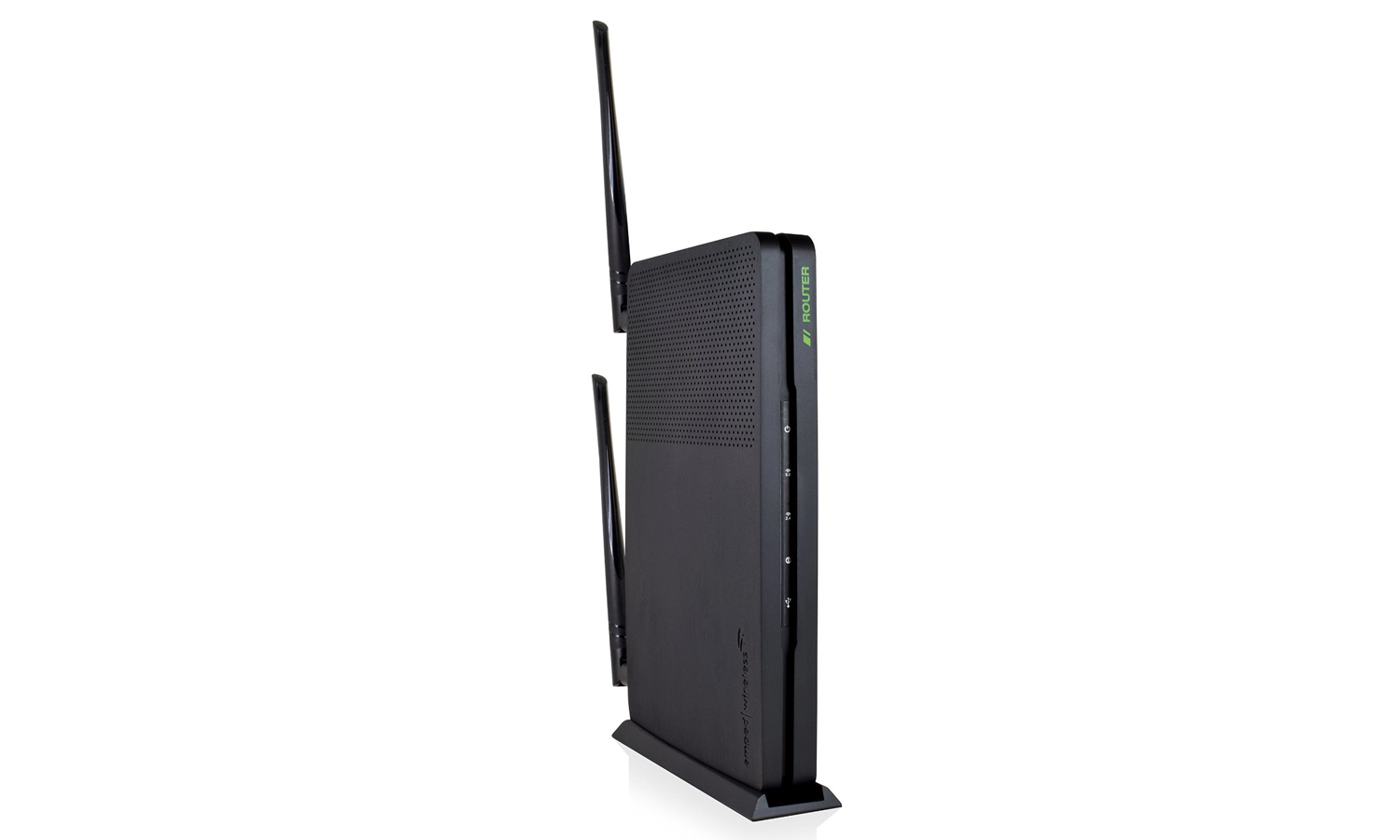Tom's Guide Verdict
Chock full of the latest wireless technology, Amped Wireless's RTA 1300M Artemis Router allows you to customize it to your heart's content while delivering strong performance, at least over short ranges.
Pros
- +
Inexpensive
- +
Good performance
- +
Eight internal signal amplifiers
- +
Extensive customization options
- +
Helpful Android app for monitoring network
Cons
- -
Short range
- -
One-year warranty
Why you can trust Tom's Guide
Editors' Note: After posting this review on July 22, 2016, we discovered an issue with our testing setup. We've retested the Amped Wireless RTA1300M Artemis router and updated this review, raising its rating to reflect its better performance in our testing.
An enviable price tag, lots of flexibility and eight individual signal amplifiers make the Amped Wireless RTA1300M Artemis router worthy of your consideration. The $130 router offers a multitude of setup options through an Android mobile app, and it delivers a lot of data while falling short on range.
Design
At 8.6 x 5.5 x 1.1 inches, the RTA1300M looks tiny compared to monster routers such as Netgear's Nighthawk X8. Subscribing to the all-black school of router design, Amped's device lacks any adornments but easily fits on a windowsill or bookshelf. Although it lacks wall-mounting holes, the router includes a snap-on stand to allow it to sit vertically.

The RTA1300M comes with a pair of large 7.6-inch antennas that have a 5dBi rating — better than the typical 3dBi stub antennas that come with most routers these days. You can rotate and angle the RTA1300M's antennas to get the strongest signal, or unscrew them for replacement.
The front of the router features a row of eight understated blue LEDs that show if the RTA1300M is turned on and whether it has an internet connection or active Wi-Fi Protected Setup (WPS). Lights also indicate activity on the 2.4- and 5-GHz bands, the four wired gigabit LAN ports and the USB 3.0 port. You can turn the LEDs off at any time.

The back of the router has buttons for turning it on or off, resetting it to its factory specs and connecting to a device via WPS. Although there isn't a switch to turn off Wi-Fi transmissions to turn it more or less into a wired router, you can do that using the router's firmware.
MORE: Don't Rent Your Router: Here Are the Best to Buy
Get instant access to breaking news, the hottest reviews, great deals and helpful tips.
Performance
Powered by Qualcomm's MU/EFX hardware, the RTA1300M Artemis router has MU-MIMO and beamforming technology that manages multiple data streams matched to the recipient's needs. Inside, the router has four signal amps for boosting the 2.4- and 5-GHz data signals. Theoretically capable of pushing 399 Mbps over its 2.4-GHz channel as well as 866 Mbps on its 5-GHz channel, the RTA1300M tops out at a total of 1.265 Gbps of throughput potential.
In our real-world testing using Ixia's IxChariot software in a crowded Wi-Fi environment, the RTA1300M started off strong. Its 2.4-GHz performance of 81.1 Mbps of throughput at 5 feet was ahead of the Linksys WRT1900ACS (35.7 Mbps). While the RTA1300M's throughput rose to 93.0 Mbps at 15 feet, its throughput dropped to 15.3 Mbps at 140 feet. At that distance, the Netgear R6220 managed to beat it with 27 Mbps.
The RTA1300M comes with a pair of big antennas that have a 5dBi rating — better than the typical 3dBi stub antennas that come with most routers these days.
In 5-GHz mode, the router managed to move a peak of 578.1 Mbps at 5 feet, with throughput dropping to 138.5 Mbps at 140 feet. By contrast, the WRT1900ACS could push 342 Mbps and 205 Mbps at those respective distances, while the R6220 delivered 319 Mbps and 282.8 Mbps at 5 and 140 feet, respectively.
This added up to a peak throughput of 659.2 Mbps at 5 feet for the RTA1300M. That's nearly double the 377.7Mbps that the R6220 recorded at 5 feet.
When I used a Microsoft Surface 3 tablet to connect to the RTA1300M, the router's signal died out at 90 feet. That's better than Netgear's R8000 managed but worse than most of the routers we've tested. The RTA1300M was able to pass our informal saturation test by reliably delivering data to a MacBook Air connecting to an internet radio station, an iPad Pro playing movies and a Samsung TabPro S displaying YouTube videos, all while a Surface 3 was moving data onto and off of a networked server.
Setup, Warranty and Support
The RTA1300M's setup is quick and easy, though the router comes with generic network names and security keys that make it an easy target for hackers. I'd suggest changing these as soon as possible.

Amped's Setup Wizard has places to update the network names, passcodes, encryption techniques, and the router's name and password. After a restart, the router was ready and connected on the first try, requiring just 15 minutes of setup time. In case you run into trouble, Amped has a wide variety of online materials to help you install and use its networking products, and its tech-support desk is staffed for 12 hours on most weekdays and 9 to 11 hours on Fridays, Saturdays and Sundays.
Like many of its peers, Amped Wireless stands by its hardware for only a year. But other companies offer longer warranties; TRENDnet, for example, includes a three-year warranty on its routers.
MORE: The Best Cable Modems to Cut Your Internet Bill
Customization
Overall, the RTA1300M's interface is bright and open. You can keep tabs on your network with Amped's Wi-Fi Analytics Tools. With the software, you can look at fever graphs of signal strength and interfering channels, but you can't make changes. The Amped application is available for Android devices and PCs, but not Macs or iOS devices.
The main window of the RTA1300M's Dashboard application displays a prominent green check mark when you're online. On this page, you can change things such as the network names, encryption levels and passcodes. At the bottom, a status list shows the IP address and firmware version.

There's a list of detailed sections on the left for Wi-Fi and network settings, USB ports and the firewall settings. For instance, you can click or tap on either 2.4- or 5-GHz Wi-Fi Settings and then on Wireless Coverage to adjust the device's transmission level to 15, 35, 70 or 100 percent if you want to keep your transmissions on your property and away from hackers and bandwidth thieves.
As is the case with many other Amped products, you can customize the wireless settings to exactly what you want or leave them alone. You can change things such as the Beacon Interval (how often the router sends signals to connected devices) and the RTS Threshold (how quickly the data channel gets cleared), and — unlike on many rival products — turn off the router's beamforming for shaping transmissions to suit a receiving device. You may want to do this if beamforming is performing erratically in a smaller setting.
When I used a Surface 3 tablet to connect to the RTA1300M, the router's signal died out at just 90 feet.
In addition to making changes to the firewall and configuring up to four guest networks for each band, you can set up a USB-connected storage device (for example, a hard drive or thumb drive) that network participants can share. Inside the Quality of Service tab, you can tell the router which devices get data priority. Just select them from a list of connected clients, or do it based on their MAC or IP addresses.
The Management section of Amped's software has detailed data-flow specs that can help tweak a router. One downside is that, unlike the TRENDnet TEW-827DRU's data, which is displayed in bar charts, all of the RTA1300M's data is tabular, making it harder to figure out visually.
Security and Parental Controls
The RTA1300M can connect with anything from Wired Equivalent Privacy (WEP) to the latest Wi-Fi Protected Access (WPA 2) encryption. With both Network Address Translation and Stateful Packet Inspection firewalls, the RTA1300M can separate you from the wild world of the web. Still, gamers can set up port forwarding and DMZ instructions to avoid conflicts.
The RTA1300M's parental controls let you block objectionable sites, but you need to create your own blacklist. It can also establish an internet usage schedule, blocking access to the network at selected times for devices you designate.
Bottom Line
The Amped Wireless RTA1300M Artemis router is affordable, supports the latest wireless technology and offers a slew of customization options. While its excellent performance was balanced by its sub-par range, the RTA1300M is a good buy that can outperform some more expensive routers.
Brian Nadel is a freelance writer and editor who specializes in technology reporting and reviewing. He works out of the suburban New York City area and has covered topics from nuclear power plants and Wi-Fi routers to cars and tablets. The former editor-in-chief of Mobile Computing and Communications, Nadel is the recipient of the TransPacific Writing Award.

